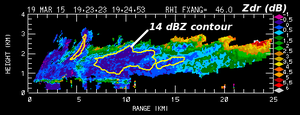Template:Featured Image/April, 2015: Difference between revisions
From CSU-CHILL
Pat kennedy (talk | contribs) (Initial posting) |
Pat kennedy (talk | contribs) (wording adjustment) |
||
| Line 1: | Line 1: | ||
{{POTM|image=19mar2015 Z Zdr anticorrelation anot.png|200px|title=Z - Zdr anti-correlation in an RHI scan through an ice cloud|credit=Patrick Kennedy|text=Differential reflectivity (Zdr) values are most positive in the outer, low-reflectivity regions of an echo layer where the scatterers are mainly horizontally-oriented planar ice crystals. In the higher reflectivity regions enclosed by the yellow 14 dBZ contour, the presence of quasi-spherical clumps of aggregated ice crystals lowers the Zdr to ~0 dB.}} | {{POTM|image=19mar2015 Z Zdr anticorrelation anot.png|200px|title=Z - Zdr anti-correlation in an RHI scan through an ice cloud|credit=Patrick Kennedy|text=Differential reflectivity (Zdr) values are most positive in the outer, low-reflectivity regions of an echo layer where the scatterers are mainly horizontally-oriented planar ice crystals. In the higher reflectivity regions enclosed by the yellow 14 dBZ contour, the presence of quasi-spherical hydrometeors, such as clumps of aggregated ice crystals, lowers the Zdr to ~0 dB.}} | ||
Latest revision as of 15:47, 30 March 2015

|
Z - Zdr anti-correlation in an RHI scan through an ice cloud Differential reflectivity (Zdr) values are most positive in the outer, low-reflectivity regions of an echo layer where the scatterers are mainly horizontally-oriented planar ice crystals. In the higher reflectivity regions enclosed by the yellow 14 dBZ contour, the presence of quasi-spherical hydrometeors, such as clumps of aggregated ice crystals, lowers the Zdr to ~0 dB. Photo credit: Patrick Kennedy |